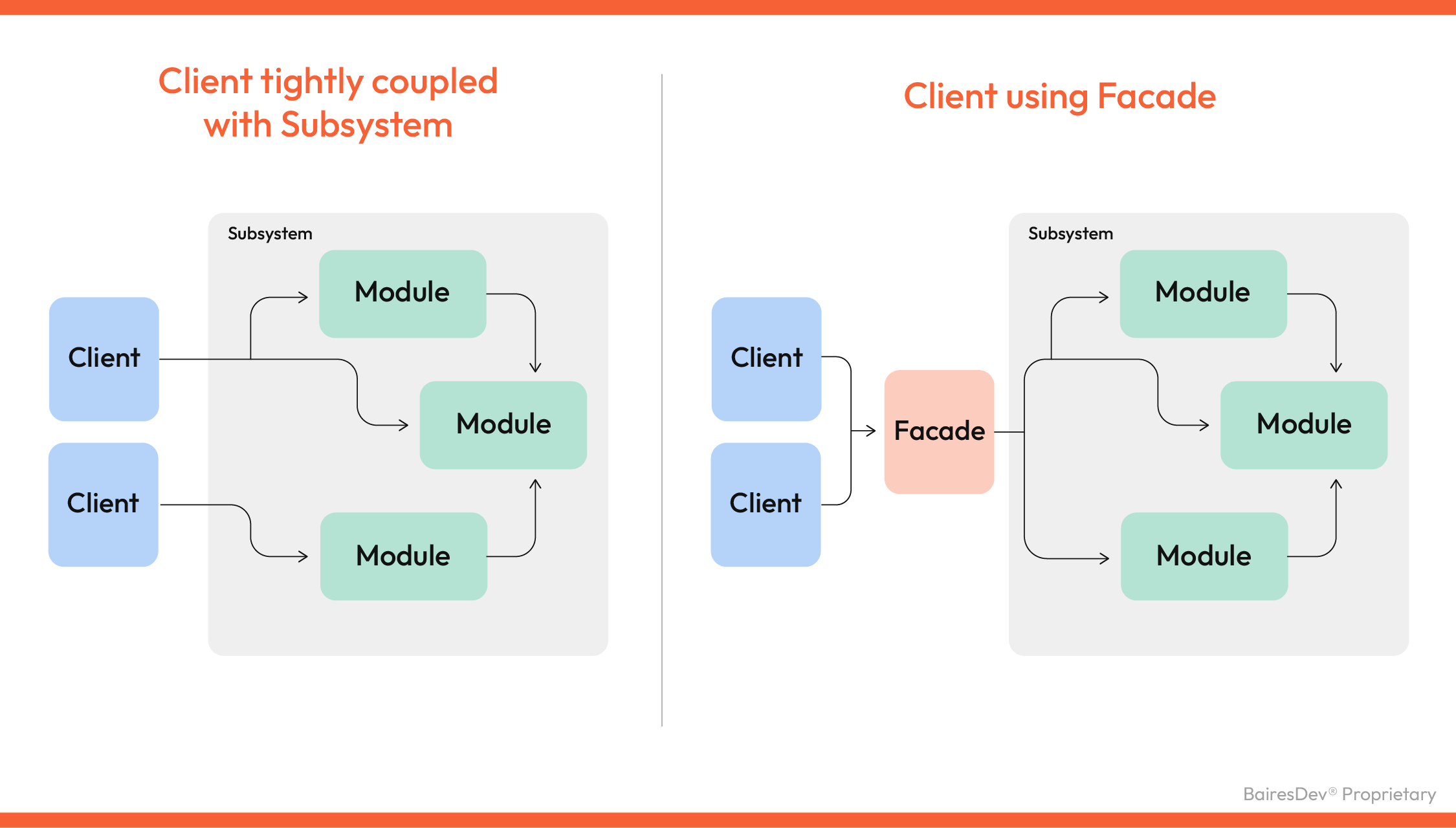Discover the simplicity of the Java Facade Pattern with our detailed explanation and practical examples – simplify your code and improve your architecture.

Tired of the tangled spaghetti code that gives you headaches? Struggling with complex software that is confusing to work with and difficult to maintain? So let's talk about facades – no, not building facades, but facade design patterns in Java.
Facade patterns provide a simple, easy-to-understand interface that hides the confusing complexity of the underlying system. Think of them like the valet at a fancy restaurant, presenting only the essentials while all the complicated work happens seamlessly behind the scenes.
In this article, we'll explore why Façade patterns are so useful, how to implement Façades in Java, and examples of Façades in action in frameworks like Spring and Java I/O. You'll learn best practices for creating elegant Facade interfaces, as well as useful tips for working with Facades without losing flexibility.
So say goodbye to tangled code and welcome clean and simplified design with Java Facade patterns! We'll have that spaghetti untied and tidy in no time. Read on to start bringing order to your unruly codebase.
What are software design patterns?
Software design patterns are like blueprints for solving common problems in software design. They represent best practices developed by experienced software developers and provide a framework that can help us write code that is easier to understand, maintain, and scale.
A design pattern is not a finished design that can be turned directly into code. It is a description or model of how to solve a problem that can be used in many different situations.
Importance of design patterns
Design patterns are reusable solutions to common problems that arise in software development. They provide a proven, standardized approach to solving specific design problems, making it easier for developers to create robust, maintainable, and scalable software systems.
Solutions for recurring problems
One of the main benefits of design patterns is that they offer solutions to recurring problems. By using a design pattern, you avoid reinventing the wheel and save time and effort finding a solution that works.
Greater readability and more efficient solutions
Design patterns also promote greater readability and more efficient solutions. By following a standardized pattern, developers can create code that is easier to understand and maintain. This is especially important in Java development, where code readability is critical for maintaining large-scale applications.
Additionally, design patterns help ensure that code is more efficient because they have been tried and tested over time. By using a proven standard, developers can avoid common pitfalls and errors, leading to faster development and better overall performance.
Better collaboration and communication
Design patterns also facilitate better collaboration and communication between developers. By using a shared vocabulary and set of standards, developers can communicate more effectively and work together more efficiently. This helps ensure that everyone involved in the project is on the same page, which is essential for delivering high-quality software solutions.
In short, design patterns are essential for Java software development because they provide a proven, standardized approach to solving common problems. By using design patterns, developers can create more robust, maintainable, and scalable software systems while improving collaboration and communication between team members.
Types
Design patterns are of various types, including low-level design patterns that are specific to the language in which they are implemented, to high-level patterns that can be implemented in any language.
In object-oriented programming, common design patterns are broadly classified into creative, structural, and behavioral patterns.
Creative Pattern
Creation patterns provide mechanisms for creating or reusing classes and objects. There are five breeding patterns:
- Abstract Factory
- Constructor
- Factory method
- Prototype
- Single.
First, they all encapsulate knowledge about which concrete classes the system uses. Second, they hide how instances of these classes are created and grouped. All the system generally knows about objects are their interfaces defined by abstract classes. Consequently, creation standards offer a lot of flexibility in what is created, who creates it, how it is created, and when.
They allow you to configure a system with “product” objects that vary widely in structure and functionality. Configuration can be static (that is, specified at compile time) or dynamic (at run time).
Structural Pattern
Structural design patterns are concerned with bringing objects and classes together into larger structures, while keeping these structures flexible and efficient. This pattern is particularly useful for making independently developed class libraries work together. Some common structural design patterns are decorator, adapter, and constructor.
Behavioral Pattern
Behavioral patterns are concerned with algorithms and the assignment of responsibilities between objects. They describe how objects communicate with each other. Some frequently used behavioral patterns include Observer, Iterator, State, and Mediator.
Facade pattern
The facade design pattern is used to simplify the interaction between clients and subsystems.
A facade object provides a simple interface to a set of interfaces in a complex subsystem, facilitating its use.
Example – audio player
Let's imagine a simple audio system. First, we have a MediaSource class that returns information about all media sources present. When getAudioSource is invoked, we get the audio source to play our audio. The Path.exists function that checks whether a given path is valid or not. AudioDecoder decodes an audio file and provides an Audio object that can be played.
All of these methods and classes are hypothetical, but this is what a typical audio playback service would look like.
class Audio {}
class AudioSource {
void play ( Audio audio ) {}
void pause {}
void resume {}
}
class MediaSource {
static AudioSource getAudioSources {}
}
classPath {
static boolean exists ( String pathname ) {}
}
class AudioDecoder {
Audio decode ( String fileName ) {}
}
Using these modules directly can make our code complicated and error-prone. Therefore, it is better to create a facade class that interacts with these modules and use the facade class. These constructions are quite common. You may have implemented a facade without knowing it.
class AudioPlayer {
AudioDecoder decoder ;
AudioSource source ;
AudioPlayer {
this. source = MediaSource . getAudioSource ;
this. decoder = new AudioDecoder ;
}
Use cases
In this section, we'll look at scenarios where you might consider using the facade design pattern.
Simple interface for a complex subsystem
Imagine you are working on a module with several classes that offer different functionality, and you only want a subset of that functionality. Consuming it directly can cause your code to become coupled, making debugging difficult. The facade object, you can only expose the necessary functionality, making your code easier to manage.
Decoupling dependencies between clients and subsystem classes
As codebases become increasingly complex, their classes become more tightly coupled. It becomes harder to maintain and easier to introduce bugs. The facade pattern can be used to decouple the subsystem from the clients.

Create a single entry point
Use it when you want a single entry point into your subsystem. In the audio player example, we had some modules to work with audio. If we use these modules in multiple places in our codebase, it will be difficult to introduce new functionality into our audio player. This problem can be solved using a facade class. Each time we need to make changes to the behavior of our audio player, we just need to change the facade class.
Conclusion
Facade is a typical design pattern that simplifies the interaction between two systems. Working in any Java IDE, you can use this design pattern to refactor your code whenever it becomes too interconnected or complex.
Common questions
What are some examples of facade software design patterns?
- The JDBC interface in Java, which provides a uniform way to access different types of databases without exposing the implementation details of each driver.
- JavaServer Faces (JSF): JSF is a framework for building component-based user interfaces for web applications in Java. It provides a facade for underlying technologies such as servlets, JSPs, and HTML rendering.
- Java Message Service (JMS): JMS is an API for sending messages between two or more clients. It provides a facade for the underlying messaging system, hiding the details of the message format and transport protocol.
What is the difference between facade and adapter pattern?
The facade pattern simplifies interaction with complex systems, including complex data structures, by providing a simplified interface that hides the underlying complexity. On the other hand, the adapter pattern allows the integration of different data structures, converting one class interface into another, allowing compatibility between different system components.




















































